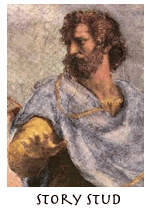 Here is the rest of my heinously abridged version of Aristotle’s Poetics – just parts that are important for screenwriters to know. (Part I is here.) Studying the real thing is better, and you can view it here.
Here is the rest of my heinously abridged version of Aristotle’s Poetics – just parts that are important for screenwriters to know. (Part I is here.) Studying the real thing is better, and you can view it here.
Reversal of the Situation is a change by which the action veers round to its opposite, subject always to our rule of probability or necessity. Recognition is a change from ignorance to knowledge, producing love or hate between the persons destined by the poet for good or bad fortune. The best form of recognition is coincident with a Reversal of the Situation. the recognition which is most intimately connected with the plot and action is, as we have said, the recognition of persons. This recognition, combined with Reversal, will produce either pity or fear; and actions producing these effects are those which, by our definition, Tragedy represents.
Two parts, then, of the Plot – Reversal of the Situation and Recognition – turn upon surprises. A third part is the Scene of Suffering. The Scene of Suffering is a destructive or painful action, such as death on the stage, bodily agony, wounds, and the like.
A perfect tragedy should, as we have seen, be arranged not on the simple but on the complex plan. It should, moreover, imitate actions which excite pity and fear – that of a man who is not eminently good and just, yet whose misfortune is brought about not by vice or depravity, but by some error or frailty.
A well-constructed plot should, therefore, be single in its issue. The change of fortune should be not from bad to good, but, reversely, from good to bad.
Fear and pity may be aroused by spectacular means; but they may also result from the inner structure of the piece, which is the better way. Actions capable of this effect [should] occur between those who are near or dear to one another – if, for example, a brother kills, or intends to kill, a brother, a son his father, a mother her son, a son his mother, or any other deed of the kind is done – these are the situations [that inspire pity and fear].
Now any speech or action that manifests moral purpose of any kind will be expressive of character: the character will be good if the purpose is good. As in the structure of the plot, so too in the portraiture of character, the poet should always aim either at the necessary or the probable. Thus a person of a given character should speak or act in a given way.
It is therefore evident that the unraveling of the plot, no less than the complication, must arise out of the plot itself.
Of all recognitions, the best is that which arises from the incidents themselves, where the startling discovery is made by natural means.
In constructing the plot, the poet should place the scene, as far as possible, before his eyes. In this way, seeing everything with the utmost vividness, as if he were a spectator of the action, he will discover what is in keeping with it, and be most unlikely to overlook inconsistencies.
As for the story, whether the poet takes it ready made or constructs it for himself, he should first sketch its general outline, and then fill in the episodes and amplify in detail.
Thanks for the nice refresher. Always helpful to revisit the basic definition of what we do.
Thanks for your 3 minute Aristotle (or 2×3 min Aristotle).
I read Aristotle’s Poetics 10 years ago and it didn’t have much impact on me. Pretty dull actually.
After I read your choice bits I dug out my copy and read it again – plus I read the Introduction for the first time (which in this edition is longer than the main text). The Introduction explained a lot. The Poetics is actually a lecture or rather notes he wrote to have on hand when he gave lectures on the subject. It’s not a carefully prepared manuscript, it’s something he wrote as a reminder to himself. Which explains its sloppiness.
qsv0vcozo8mv9h76
You can definitely see your skills in the work you write. The world hopes for even more passionate writers like you who are not afraid to say how they believe. Always follow your heart.